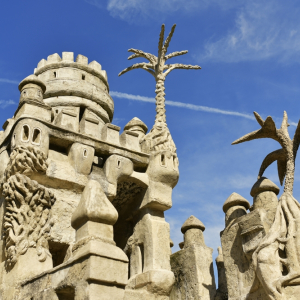- Discover
- Around Lyon
- Highlights of the region
- Palais du Facteur Cheval
Palais du Facteur Cheval
A palace of dreams
Highlights of the region
Last updated date : 19/01/2023
In the Drôme, 1¼ hours from Lyon, the peculiar ‘Palais Idéal’ (Ideal Palace) stands as a testament to the rich imagination of one determined man, who was known as Facteur Cheval (Postman Cheval).

See all pictures
Known throughout the world, the ‘Palais Idéal du Facteur Cheval’ (Postman Cheval’s Ideal Palace) is an unclassifiable art brut monument that leapt from the imagination of a self-taught creator with no artistic background.
As a distraction, in my dreams I built a fairy palace...
Joseph Ferdinand Cheval • Postman
A little bit of history...
Born in 1836, into a poor family in the Drôme, Joseph Ferdinand Cheval had various professions before returning to his region of birth at the age of 31 to become a postman. He became fascinated by the illustrated magazines and postcards he distributed along his daily 30-kilometre round. One day, when he was 43, he stumbled on a strange stone, which was a revelation. Over the next 33 years, he collected stones and rocks to build a palace from his imagination, with no rules of architecture or references to known artistic trends.
Listed as a historic monument in 1969 by the French Minister for Cultural Affairs, André Malraux, Le Palais Idéal du Facteur Cheval was a strong influence on surrealist artists (such as Max Ernst and André Breton) and Picasso.
Between 1879 and 1912
10 000 days
93 000 hours
33 years of challenges
It is a work that is rich in detail
Standing in a luxuriant garden, the Palace is a treasure to be explored. Visitors should take the time to immerse themselves in this work and its unique atmosphere, with its inscriptions, sculptures and stone stalactites. The palace is around 26 metres long, 14 metres high and 12 metres tall.
Featuring many basins, the architecture takes visitors on a voyage of discovery. Incorporating elements of an Egyptian monument, Hindu Temple, Swiss chalet, Algerian house and more, this work is permeated by humanism and universalism, inspired by the magazines distributed by a postman who had never travelled abroad.
A gallery and terrace offer various perspectives and viewpoints of the palace. The north façade is a symbiosis of the natural and supernatural, with a bestiary, monsters and floral inspiration.
